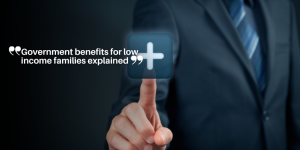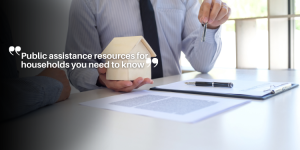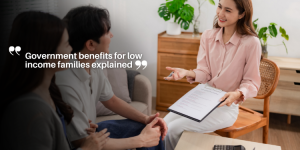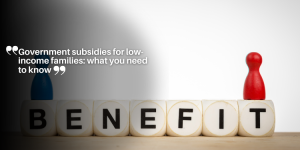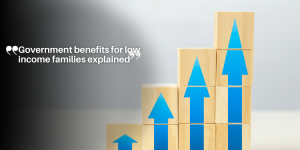Complete Guide: Government Programs That Help Pay Your Utility Bills
Introduction to Utility Assistance Programs 💡🏠
Utility bills can place a significant financial burden on low-income households.
These families often struggle to balance the cost of utilities with other essential expenses such as housing, food, and healthcare.
The unpredictability of utility costs can lead to financial instability, forcing many to make tough choices, such as forgoing necessary heating or cooling to save money.
Fortunately, several government programs are available to help these households manage their utility expenses.
Understanding these programs can be crucial for maintaining financial stability. By leveraging these resources, families can ensure their essential utility services remain uninterrupted and more affordable.
The programs available for utility assistance vary, but some of the most notable include the Low Income Home Energy Assistance Program (LIHEAP) and the Weatherization Assistance Program (WAP).
LIHEAP helps cover heating and cooling bills and offers emergency support during energy crises.
WAP focuses on reducing energy costs through home improvements, which can also enhance home safety and comfort.
Gaining knowledge of these programs, their eligibility requirements, and the application processes is essential.
It enables individuals to take proactive measures in overseeing their utility costs, reducing the risk of service disconnections, and promoting longer-term financial health.
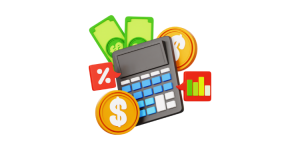
Low Income Home Energy Assistance Program (LIHEAP) 💸🔥
What Is LIHEAP?
The Low Income Home Energy Assistance Program (LIHEAP) is a federal initiative designed to help low-income households manage their heating and cooling costs.
By providing financial aid, LIHEAP ensures that families can maintain their utility services, especially during extreme weather conditions.
This assistance can cover both regular utility bills and emergency situations, such as unexpected energy crises.
Eligibility Requirements 📝
Eligibility for LIHEAP varies based on income and specific criteria set by each state.
Generally, households must have an income below a certain threshold, which is often a percentage of the federal poverty level.
Additionally, some states may consider factors like household size or participation in other federal assistance programs, such as TANF (Temporary Assistance for Needy Families) or SSI (Supplemental Security Income).
To find out if you qualify for LIHEAP, you can answer a few questions on the program’s website, which will direct you to your state’s specific requirements.
How to Locate and Apply for LIHEAP 💻📞
To apply for LIHEAP, start by locating your state’s LIHEAP office.
Most states have dedicated websites or hotlines to assist with the application process.
You can often submit your application online, while some states may require in-person submissions.
Ensure you have all necessary documentation, which typically includes proof of income, identification, and utility bills.
Understanding and utilizing programs like LIHEAP is essential for maintaining financial stability.
Awareness of available resources can significantly reduce the burden of utility bills, helping families stay warm in winter and cool in summer.
Weatherization Assistance Program (WAP) 🌞🏡
How WAP Reduces Energy Costs Through Home Improvements 🛠️
The Weatherization Assistance Program (WAP) is a vital tool in the quest to lower energy costs for low-income households.
Essentially, WAP provides free home improvements designed to enhance energy efficiency, ultimately leading to substantial savings on utility bills.
These improvements can include insulation, sealing of leaks, and repairs or upgrades to heating and cooling systems.
By improving the energy efficiency of homes, WAP not only reduces energy consumption but also improves indoor comfort and safety.
Through these initiatives, families can experience long-term savings, enjoy a more comfortable living environment, and reduce their energy-related expenses, contributing to overall financial well-being.
Eligibility Pathways Through Income Qualification or Federal Programs 🏠💼
Eligibility for the Weatherization Assistance Program (WAP) is determined by two primary factors: income level and participation in other federal assistance programs.
Households earning at or under 200% of the federal poverty threshold may qualify. Additionally, individuals already receiving benefits from programs like Temporary Assistance for Needy Families (TANF) or Supplemental Security Income (SSI) are eligible for WAP.
This broad eligibility criterion ensures that those in genuine need can access the program with relative ease.
The Application Process and Connecting with Your State’s WAP Office 📋📞
Applying for WAP involves a few straightforward steps:
-
Determine Eligibility: Check if your income level or participation in federal programs makes you eligible.
-
Locate Your State’s WAP Office: Contact information for your state’s WAP office is usually available on state government websites or through local community service organizations.
-
Submit an Application: You may need to provide documentation such as proof of income and participation in federal programs.
Each state’s WAP office manages the program slightly differently, but most offer assistance with the application process to guarantee you can obtain the benefits available.
Next, we will delve more deeply into understanding the varying utility disconnection policies across states, which are essential to preventing utility loss due to nonpayment.
Understanding Utility Disconnection Policies ⚡❄️
Staying on top of utility bills can be a major challenge, particularly for low-income households.
Understanding utility disconnection policies is crucial to ensure that essential services are uninterrupted.
Each state has different rules about when and how utility companies can disconnect services for non-payment.
These rules often include special protections under certain conditions.
State-by-State Differences 🗺️
Utility disconnection policies vary widely across the United States.
Factors influencing these policies include local weather conditions, customer demographics, and specific utility provider policies.
For example, some states prohibit disconnections during extreme weather conditions to protect vulnerable populations.
Other states may have stricter guidelines around advance notice requirements before disconnection can proceed.
Protection Factors 🛡️
Several factors can provide protection against utility disconnection:
-
Weather Conditions: Many states have regulations that prevent disconnections during extreme weather, both hot and cold, to ensure the safety of residents.
-
Age: Some states offer additional protections for elderly residents, recognizing their increased vulnerability.
-
Disability: There are often special considerations for individuals with disabilities, ensuring they maintain access to essential services.
-
Health and Safety Risks: Disconnections may be prohibited if they present a threat to health and safety, based on medical documentation provided by the customer.
Facing Potential Disconnection 💬
If you are facing a potential utility disconnection:
-
Contact Your Utility Provider: Explain your situation and ask about payment plans or extensions. Many providers have hardship programs.
-
Explore Assistance Programs: Look into programs like LIHEAP and WAP, which can provide financial assistance for utility bills.
-
Seek Legal Aid: If you believe the utility company is not following state regulations, seek advice from legal aid services.
Understanding these policies and protections can be a critical step in avoiding the disruption of essential services, thereby contributing to overall financial stability.
Armed with this information, you’ll be able to navigate the intricate landscape of utility bills more effectively.
The Lifeline Program for Phone and Internet 📱🌐
Lifeline Program Overview
The Lifeline Program offers essential support for low-income households by providing discounts on telephone and internet services.
The program ensures that basic communication tools remain accessible, helping people stay connected with loved ones, work opportunities, and emergency services.
Eligibility Criteria for the Lifeline Program 📋
In order to be eligible for the Lifeline Program, households must fulfill certain eligibility requirements based on:
-
Income: Your household earnings must be at or under 135% of the federal poverty level.
-
Federal Assistance Programs: Alternatively, you may qualify if you participate in certain federal assistance programs such as:
-
Supplemental Nutrition Assistance Program (SNAP)
-
Medicaid
-
Federal Public Housing Assistance (FPHA)
-
Supplemental Security Income (SSI)
-
Household size and participation in other federal assistance programs can also influence eligibility.
Types of Services Covered 📞🌐
Lifeline discounts are applicable to various services:
-
Landline Telephone Service: Traditional home phone lines
-
Cell Phone Service: Wireless phone plans
-
Internet Service: High-speed internet plans for both home use and mobile data
These discounts ensure that essential communication services remain affordable for those who need them the most.
Transition to the Next Topic 🔄
Understanding the Lifeline Program can greatly enhance a household’s connectivity and financial security.
Prior knowledge of eligibility criteria and application processes for utility assistance programs is crucial for maximizing benefits.
Applying for Lifeline Benefits 📝
Applying for Lifeline benefits can help reduce your phone or internet bills if you meet the eligibility requirements.
Here’s a detailed guide on how to apply, the necessary documentation, and tips for overcoming common application challenges.
Step-by-Step Application Guide 📲
Applying for Lifeline benefits can be done in three ways:
-
Online: Visit the Lifeline National Verifier website to start your application. The online platform will walk you through the steps to submit your application.
-
By Mail: Download and mail the Lifeline application form. Be sure to include copies of the required documents.
-
Through Service Providers: Many phone and internet companies can help you apply for Lifeline benefits directly. Contact your current service provider to see if they offer this service.
For more information, refer to the Universal Service Administrative Company’s (USAC).
Documentation Needed 🗂️
To prove your eligibility, you must provide specific documentation, including:
-
Proof of Income: Recent tax returns, paycheck stubs, or a letter from your employer.
-
Proof of Participation in Federal Assistance Programs: Evidence of enrollment in programs like SNAP (Supplemental Nutrition Assistance Program) or Medicaid.
-
Proof of Identity: A government-issued ID such as a driver’s license or passport.
-
Proof of Address: A recent utility bill or other proof showing your current residence.
Overcoming Common Challenges ⚠️
Applying for Lifeline benefits can sometimes be challenging. Here are common issues and how to address them:
-
Incomplete Documentation: Make sure to provide all necessary documents properly. Double-check required forms and supporting documents.
-
Application Denials: If your application is denied, contact the USAC for guidance on addressing the issues. Often, missing or incorrect documents are to blame.
-
Technical Difficulties: For online applications, technical issues can occur. If you face such problems, try applying through mail or your service provider.
Connecting with the right resources and confirmed contact points can make the process smoother and less stressful.
Troubleshooting Utility Assistance Issues 🔧
If you’re experiencing issues with your Lifeline service, it’s essential to know your resources and steps. Here are some tips to help you troubleshoot common problems effectively.
Who to Contact if You Experience Problems 📞
For issues specifically related to your Lifeline service, the first point of contact should be the Universal Service Administrative Company (USAC).
They manage the Lifeline program and can provide assistance with general inquiries and issues related to your eligibility and benefits.
If the problem is with the service itself, such as connectivity issues or billing errors, contact your phone or internet service provider directly.
Many providers have dedicated customer service lines to handle Lifeline-related queries.
How to File Complaints About Service Providers 📝
If contacting your service provider does not resolve your issue, you can escalate the complaint. Begin by documenting your calls and maintaining records of your grievances. This can include dates, times, representatives spoken to, and the details of your issue.
Then, you can file a complaint with the Federal Communications Commission (FCC).
This can be done online through their Consumer Complaint Center, by phone, or by mail.
The FCC will investigate the complaint and may pressure the service provider to resolve it satisfactorily.
Resources for Appeal if Your Application is Denied ⚖️
If your Lifeline application is denied, don’t lose hope. You have the right to appeal the decision.
Start by reviewing the denial notice; it often includes the reason for denial and the process to appeal.
You can appeal directly through the USAC.
Be prepared to provide any additional documentation that supports your eligibility. If further assistance is needed, consider reaching out to local advocacy groups or legal aid organizations that specialize in utility and consumer rights.
Effective troubleshooting and knowing the appropriate channels for escalating issues can significantly impact your experience with utility assistance programs. Remember, persistence is key.
With a focus on resolving issues promptly, you can ensure continuous utility service and maintain financial stability.
Additional Resources and State-Specific Programs 🏠💡
Other Federal and State Programs That May Provide Utility Assistance
Beyond LIHEAP, WAP, and Lifeline, several other federal and state-specific programs are available to assist with utility bills.
Programs like the Energy Assistance Fund (EAF) and the Emergency Family Assistance Fund (EFA) provide additional layers of support, focusing on families in crisis situations.
Always check with your local government offices for any state-specific programs that might be available.
Non-Profit and Community Organizations That Offer Supplemental Help 🏘️
Non-profits and community organizations play an essential role in helping low-income families manage utility costs.
Organizations like the Salvation Army, the United Way, and local churches often provide emergency assistance to cover utility bills.
Local charities and community action agencies can also be a source of critical financial help, particularly in emergencies.
How to Combine Multiple Programs for Maximum Benefit 💪
Using a combination of programs can maximize the benefits received.
For instance, you can use LIHEAP to help with immediate heating costs while applying for WAP to make your home more energy-efficient in the long term.
Similarly, combining Lifeline benefits for phone or internet services with local community grants can ensure greater financial relief.
Don’t hesitate to reach out to social workers or advocates to guide you through the process.
By diversifying the resources you tap into, you can better manage and stabilize your financial situation over the long term.
This holistic approach ensures you are not solely dependent on one source of assistance, providing greater security and peace of mind.
Planning Ahead: Long-Term Energy Savings 🔋
Managing utility bills effectively involves more than just seeking immediate assistance.
By planning for long-term energy savings, households can achieve greater financial stability and reduce their dependency on external help.
Energy Conservation Tips to Reduce Utility Bills 🌍
| Tip | Description |
|---|---|
| Use Energy-Efficient Appliances | Switch to ENERGY STAR-rated appliances that consume less electricity. |
| Seal Doors and Windows | Check for drafts and close any openings using weatherstripping or caulking. |
| Adjust Thermostat Settings | Reduce thermostat setting by a few degrees in winter, raise it in summer for savings. |
| Utilize Natural Lighting | Use sunlight throughout the day, and opt for LED lighting for artificial lighting. |
| Disconnect Electronics | Unplug electronics when not in use to avoid standby power consumption. |
How Weatherization Improvements Continue to Save Money Over Time 🏡💰
Investing in home weatherization through programs like the Weatherization Assistance Program (WAP) can lead to sizable energy bill reductions. Weatherization improvements may include:
-
Upgrading insulation in walls, attics, and basements
-
Installing energy-efficient windows and doors
-
Repairing or replacing heating and cooling systems
-
Sealing ducts to enhance HVAC efficiency
These upgrades enhance your home’s energy efficiency, which means lower utility bills for years to come.
For example, insulating and sealing air leaks can lower your heating and cooling costs by about 15%, reducing expenses and providing a more comfortable living environment.
Budgeting Strategies for Managing Seasonal Utility Cost Fluctuations 📅💡
Utility costs often fluctuate with the seasons. Planning ahead and using smart budgeting strategies can help manage these variations:
-
Spread Out Costs: Some utility companies offer budget billing programs that average your annual usage, allowing you to pay a consistent amount each month.
-
Build a Utility Fund: Save a little each month by depositing a set amount into a dedicated account meant for covering higher utility bills during peak seasons.
-
Monitor Usage: Keep track of your energy usage with smart meters or apps offered by your utility provider. This helps you adjust habits to prevent bill spikes.
-
Emergency Fund: Keep a modest reserve of funds on hand to handle unforeseen expenses, high bills, or emergencies, ensuring you’re always prepared.
Through the application of these approaches, you can handle your utility expenses more effectively, reducing stress and increasing financial stability.
Planning ahead ensures you’re better equipped to handle the fluctuations in energy costs that come with changing seasons.


